Andrew Lister was always going to be an artist. “Art was the only thing I was ever good at, and the only thing I was ever interested in.” Court Spencer visited him in his studio to find out more about his work and what inspires him.
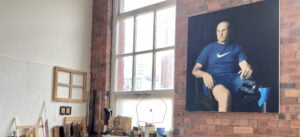
Andrew Lister’s studio. Credit: Court Spencer
Court: Hi, thanks for having me over and for agreeing to be interviewed. So let’s start with your work. You make paintings, sculptural pieces or assemblages, and you also work with inlay. Could you give us a bit of an introduction to your work?
Andrew: I think my approach is still largely determined by the way I was taught in Art College. My foundation course dealt with traditional methods and materials, introducing us, for example, to oil paint and how it could be used but we were also encouraged to collect any materials we could lay our hands on and we used this stuff in the studio to experiment with and make both 2D and 3D work. My degree course put a strong emphasis on discussing ideas and analyzing them before finding the most appropriate way of expressing them. And no way of doing this was ruled out, so painting and sculpture went on but so also did installations and performance pieces. In one extreme case a fellow student brought a goat into the studio and attempted to teach it English.
So my use of 2D and 3D and employment of different materials in different works now can be seen (goat excepted) to my experience as an art student. This is largely to do with method and how that had an impact on my subsequent work. I would add that etching (of which I did a substantial amount as a student) influenced me in a more direct way. The tussle I had with the metal surface of the etching plate, to get it to print what I wanted – the scraping and cutting as well as the actual etching in the acid bath – is closely connected to the struggle I have today with tin, wood, pottery shards and whatever else forms the surface of my work.
Court: It sounds like there was such a sense of freedom to explore materials. Had you always had an interest in art? How did you come to working in the arts?
Andrew: At school, art was the only subject I enjoyed. When doing my A levels I attended Saturday morning classes at Leeds College of Art. In one of the first classes a teacher praised one of my drawings, this was the first time I had received any praise. It certainly wasn’t anything I received at school, and it was this that gave me confidence and soon I felt very comfortable with the teachers, the other students and the studio environment. I started to think that maybe this was for me, and from that point onwards I was heading towards art college and the world of fine art.
My route to working as a teacher took one odd turn. Soon after I graduated I was given a part-time teaching role in the fine art department of the college in South Wales where I had been a degree student. This seemingly ideal situation of having money and time to carry on with my own work soon became very difficult. I was young and soon became more involved in the work of the students than I was in my own. I left teaching to look for work that would not impinge on my own work so that I could develop it on my own terms. Eventually I took over my father’s shop, a second-hand business, and I worked as a junk dealer for fifteen years before returning to teaching in Leeds College of Art.
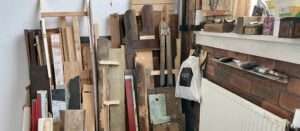
Wood pile in the studio. Credit: Court Spencer
Court: Speaking of materials, can I just say that your wood pile is looking as splendid as ever! Has wood and found materials always been a part of your practice?
Andrew: Yes my wood pile has accepted a lot of praise over the years but manages to retain its modesty. When I first left college, despite the experience it had given me in all manner of materials and ways of working, I spent my time making figurative paintings on canvas. Curiously it was old wood I had collected from a local demolition site to burn to keep warm when I had the junk shop that diverted me from the paintings and has been diverting me ever since.
The motley collection of firewood was spread out on the floor to dry so that I could burn it. Having it spread out like this I suddenly saw the potential of its bleached and blotched surfaces and its rich variety of fading, flaking paint. My painting had run into the buffers at the time. I was struggling with the way paint could be used to answer the problems I had posed; I was confused. Joining and shaping old wood, crafting it at first on its own and then with other materials had limitations that I had to work with. It forced me to be decisive and interpret the images I was working with rather than copying them as I had been doing with paint.
Court: There are some recurring themes in your work, and reoccurring materials and techniques. Could you please talk us through some of those?
Andrew: The recurring themes are war and the history of art. I am interested in current affairs and the way images of war are used in newspapers and magazines. I chose to use war images in my work partly because they are seen by many people and partly because they deal with horror and destruction, a foil to the materials I was using to transcribe them, mainly old woods, that are modestly beautiful and have the patina of honesty and hard work.
The history of art has always fascinated me so again I possessed its images. I used images of famous paintings because they are easily recognizable and retain their identity even after much deliberate distortion, distortion that is necessary to give the materials used in transcribing the painted surface a language that is true to itself. Making the materials create their own language allows the object they form to exist in its own right. It also answers the question about preparatory drawings and why they do not exist for these works. Drawing, especially from observation, is important to me. But the ‘drawing’ for these constructed works goes hand in hand with the materials and happens in the construction. It cannot be predicted or worked out beforehand: it has to be a response to how the materials and image interact when they are put together when the work is in progress.
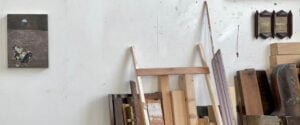
Moon Landing by Andrew Lister. Credit: Court Spencer.
Court: You’ve spoken about the materials you use and the themes you explore. Can you tell us a bit about where you find source material in terms of imagery that you might decide to paint, collage or inlay?
Andrew: War and art history have been important but not the only subject matter. Just as I am always on the lookout for materials to work with, so too for images to use as subject matter. To keep my wood-pile company I have a large collection of images: post cards, cuttings, photocopies, that someday might become useful.
Court: How are these images chosen?
Andrew: Whimsically sometimes, or I might respond to something formal like a colour combination. Often it relates to subject matter. But sometimes the choice is quite specific. At the time when I was first experimenting with tin, cutting shapes of different colours from old tin boxes, I saw a newspaper article about the Paddington train crash. I immediately realized that the accompanying photograph of the wreckage could be evoked by nailing down the shapes of tin in a kind of mosaic to recreate the photographic image.
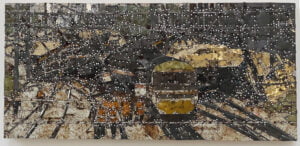
Paddington Train Crash by Andrew Lister.
Court: How do you feel your role as a lecturer has impacted your practice?
Andrew: Well even though I was only ever a part-time teacher it gave me the money to live on and so relieved me of the pressures of trying to make my work saleable. But it was great to be with young people who were full of energy, daftness, ideas and enthusiasm. Whatever else art colleges do, they thrive on experiment and energy. It is not as manic in Patrick Studios but fellow studio holders often proffer help and there is something of the art college about the place: foibles and insanity are made very welcome; it is part of the reason why at my almighty age I carry on working.
Court: Haha. Are there any other reasons?
Andrew: I love crafting images and I love manipulating materials. It is still magic to me. But the crux of the matter is that I am never really happy with what I have done and carry on with the deluded hope (and genuine wish) of doing something better.
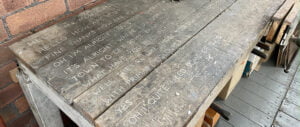
Hello Mr. Mondrian by Andrew Lister. Credit: Court Spencer
Court: You’ve got fantastic drive. What have been some of your career highlights to date?
Getting a wood-cut into a public collection in Brno, Czech Republic, and winning a prize in a Connecticut Gallery for a woodcut transcription of a Uccello painting. Closer to home, winning The Leeds Art Fair, exhibiting work with Rosie Vohra in Assembly House was good, mainly because of Rosie who is fab – and showing work in St Edmunds church on a couple of occasions, courtesy of the wonderful Si Smith, was well worth doing.
Court: Do you have a dream project that you would love to make happen?
Using re-cycled wood, substantial old floorboards for example, to make a large version of my Teapot and Sausages Piece. Possibly 15 or 16 feet tall. Domesticity writ large.
Court: I know you’ve recently started using Instagram (@aslister1). Is that the best way for people to follow your work and see what you’re up to?
Because key elements of my work have such a physical presence and tactile surface qualities the best way of knowing my work is to see it in the flesh.
Court: Well, I would love that! I really hope I get to see more of your work that you’ve got beautifully stacked up in the studio sometime soon. Thank you so much for your time today and I look forward to seeing more of your work.
Filed under: Art & Photography
Tagged with: Andrew lister, art, art career, art college, court Spencer, interview, Leeds art, material art, materials, Northern Art, sculpture, Studio, studio visit, wood

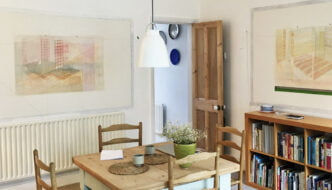
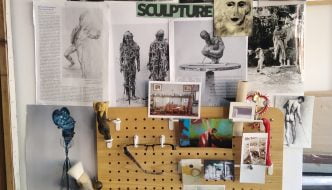
Comments